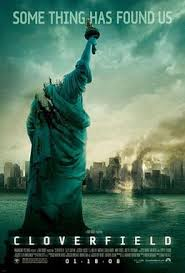Cloverfield

Movie Info:
🧠 Plot Summary
Matt Reeves directed Cloverfield in 2008, and J.J. Abrams produced it. This movie has been classified as a found footage monster thriller. It also reinvents the kaiju genre as a deeply personal piece of art, and it is set in contemporary Manhattan. The film captures the chaos of a single night in the city where a gigantic and unknown creature emerges from the ocean and causes catastrophe.
In this case, the story is told through a recovering SD memory card from a camcorder, which belonged to Rob Hawkins (Michael Stahl-David) who was being recorded by his friend Hud (T.J. Miller) at his going away party. Rob has accepted a job in Japan, and the celebration is a backdrop for unresolved feelings between him and Beth (Odette Yustman), his close friend. The celebration is shattered, however, by an earth-shaking explosive and blackout that causes the partygoers to rush to the rooftop. There they witness the unthinkable: an explosion in downtown Manhattan, and the head of the Statue of Liberty crashing onto the street.
As Rob’s world is crumbling and the military goes into the city, he learns that Beth is stuck in her apartment uptown. Despite the city being evacuated, Rob decides to search for her, leading a group of survivors including Hud, Marlena (Lizzy Caplan), and Rob’s brother’s girlfriend Lily (Jessica Lucas) through monstrous battles, building collapses, and sheer dread.
Rob’s group also faces bombardment from military forces, which coupled with battling the City and obliterating parasitic creatures, proves to be equally challenging. Hud records everything, giving the film a unique, unpolished, first-person feel. Every route they take is emotionally draining, filled with senseless violence, and small snippets of friendliness intertwined between worlds of carnage.
Rob and Beth’s final scene reveals them taking shelter while the military assaults the city with a supposed nuclear strike. The footage abruptly fades out, leaving viewers uneasy with the protagonist’s and creature’s outcomes.
🎭 Characters and Performances
Michael Stahl-David as Rob Hawkins
Rob is yet another quintessential, classic, reluctant hero. Throughout the adnarrative, Rob is stuck balancing his career and personal life. Choosing to rescue Beth against all odds transforms him into an emotionally drawn and selfish character at the core. With a chaotic world around him, the decision becomes the focal point of the storyline and emotional peak. Acting brilliantly through still unity, Rob has become a hero sympathetic to audiences, yet fascinating.
Beth McIntyre (Odette Yustman)
Fragmentary as her role is, Beth is critical to Rob’s narrative. Her character adds emotional stakes to the story, and her eventual rescue pays off the relationship tension that has built up earlier. Yustman’s performance captures both her strength and fragility, which, though brief, is unforgettable.
Hud Platt (T.J. Miller)
As the cameraman and the film’s source of humor, he lightens the mood in an otherwise dark and serious story. Although his commentary is often funny, it becomes more frantic and desperate as the events unfold. Given that most of the film is presented through his lens, Miller’s voice acting is critical.
Marlena Diamond (Lizzy Caplan)
Marlena embodies cynical skepticism tempered with some soft, hidden vulnerability. Lizzy Caplan’s portrayal certainly brought more emotion to the film, particularly when she met her tragic end after being bitten by one of the parasite-like creatures. Body horror is central to the film’s themes and Marlena’s shocking death adds a horrific dimension.
Lily Ford (Jessica Lucas)
Lily counters the hysteria with her determination and resourcefulness. As panic takes hold of those around her, she steps up as a leader and becomes more inclined to fight for her survival. Her rescue by helicopter is one of the film’s few hopeful moments.
🎥 Themes and Symbolism
Found-Footage Realism
Using a camcorder to tell this story is not a mere stylistic choice but instead serves to ground viewers within the chaotic experiences of the narrative in real time. The combination of unstable visuals, abrupt edits, and candid shots creates a tone that parallels the trauma associated with enduring a disaster.
Post 9/11 Allegory
Cloverfield eerily captures the psychological impact of 9/11 through visuals like collapsing buildings, survivors covered in ash, and pervasive dread. The film offers no explanation—only survival amidst chaos—which portrays a contemporary urban nightmare.
The Limits of Control
All the characters confront an overwhelming situation. Their individual strife—including lost romances, uncommunicated sentiments, and hopeless ambitions—pales in the face of overwhelming catastrophe. This denial of control creates a counter-monster narrative that becomes unexpectedly profound.
Love Amid Annihilation
In the context of a world unraveling, Rob’s futile attempt to rescue Beth serves as a metaphor for the struggle to preserve attachment and significance. In a tale dominated by destruction, this act of human connection acts as an emotional anchor.
🎞️ Cinematic Style and Atmoshphere
The direction of Matt Reeves, alongside Drew Goddard’s screenplay and Michael Giacchino’s sparse but telling score (which is only present during the credits), creates a world that is believable and relentlessly harsh. The found-footage style integrates into the film’s narrative seamlessly; it is not there simply as a gimmick. The audience is made to feel claustrophobically confined in the same space as the characters.
While the visual effects are sparing with their complete creature reveals, the portions that are shown are horrifying and convincing. The creature design is purposefully unclear, heightening the dread and mystery. Sudden parasitic creature explosions and wide-scale city destruction shot with documentary-style immediacy serve to heighten the horror.
Lighting in the scene where the handheld camera light flickers, military explosions create dark flare strikes, or flickering lights gives off a handheld glow, creates tension and chaos from a disorienting perspective and enhances the sheer panic and confusion of the situation.
⭐ Reception and Interpretation
Critical Response
Cloverfield was an immediate hit with critics, who celebrated its unique high-concept premise, use of suspense, and stylistic risk taking. Reviewers praised the film for its well-executed found footage style, impressive pacing, and captivating immersiveness. Moreover, its revival of the monster movie genre in the post-2000s era was also highly commended.
Box Office and Audience Response
It is estimated that the film generated revenue of over 170 million dollars worldwide while the production budget was only 25 million dollars, making it a massive financial success. Audience reception was split regarding the found-footage format; some viewers enjoyed it as a unique storytelling technique, while others criticized it as a jarring approach. Regardless, it created a franchise and stimulated the rise of films within the same genre.
📽️ Key Takeaways for Viewers
The monster in Cloverfield serves less as the focus of the narrative and more as a device to explore themes of survival, memory, and human endurance in the battle against horror.
Monsters and fictional disasters like the one portrayed in the movie are often depicted on the screen without any context. By not providing an explanation to the creature and events taking place, it receives a greater spine-chilling undertone.
The emotion that viewers experience due to the found footage style of the recording transforms the scenes of large-scale destruction into private loss, therefore, increasing the viewers’ empathy.
✅ Verdict
Cloverfield (2008) is a landmark work for the genre of modern horror and in this case, films revolving around monstrous creatures. The use of inventive techniques and unwavering suspense saw the movie gain world fame almost instantly. Despite being recently released in the 2000s, it incorporated elements of love, loss, and memory alongside destruction which makes the experience of watching it cathartic yet intimate. Apart from the raw human emotion present in the movie, the terror displayed is spine-chilling.








